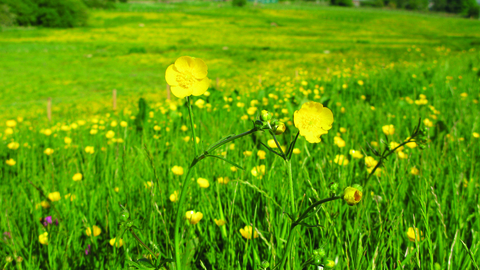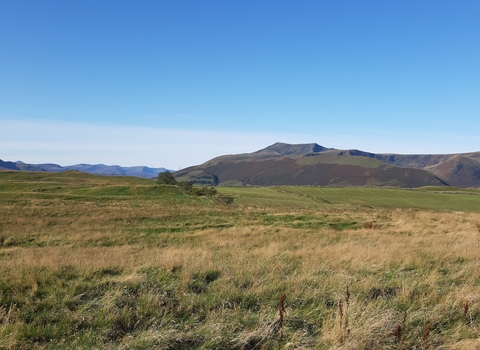
Thacka Beck Nature Reserve © Lee Schofield
Location
Know before you go
Dogs
When to visit
Opening times
Open all year roundBest time to visit
All year roundAbout the reserve
Wildlife highlights
- In spring -blackthorn and other blossom, returning migrant birds and marsh marigolds.
- In summer - butterflies in the hay meadows and swallows, house martins and swifts catch insects over the ponds. Enjoy the splashes of summer colour in the hay meadows.
- In autumn - flocks of fieldfare and redwing feed in the hedgerows whilst the thistles and knapweed attract flocks of goldfinch.
- In Winter - residents include mallards and moorhen.
Flood relief
Created to provide flood protection for Penrith, this nature reserve supports an impressive diversity of habitats.
From the hay meadows, wet grassland, scrub, hedges and ponds to the beck itself, a wealth of wildlife is found across the site.
What makes Thacka Beck so special?
The flood basin has helped to raise the water table and created areas of wet grassland either side of the re-routed beck, which is rich in invertebrates and vital for many breeding and feeding birds such as teal, yellow wagtail and snipe.
In order to keep the sward short and appealing to these species, Cumbria Wildlife Trust employs a carefully managed grazing regime.
Despite the nature reserve’s small size, a remarkable number of bird species has been recorded. The nature reserve has something to offer all year; follow the circular route around the flood storage basin to see what you can discover.
During the spring frogs and toads make their way to the ponds and scrapes to spawn, some having spent the winter in the damp conditions provided by log piles or the bottom of dry stone walls.
Dragonflies emerge at about the same time and can be seen hunting for insects.
Hay meadows
Two drier fields within the nature reserve are being managed as hay meadows and the summertime display attracts many butterflies including meadow brown, small copper and ringlet.
When Cumbria Wildlife Trust took over the management of Thacka Beck these fields were in a poor state and were overgrown with tussocky grasses, nettles and thistles. Some plants of interest still remained however, particularly in the western field.
An annual hay cut, grazing, weed control and limited seeding are bringing about improvements, and the number of species is increasing.
Look out for water avens, great burnet, meadowsweet and knapweed, all of which add lovely splashes of colour to the summer scene.
Mature hedges
The very mature hedge that runs along the eastern edge of the flood storage basin is a great place to look for passerines (small perching birds).
Hedges that are left to develop without cutting often produce more fruit than their tidy cousins and this hedge is no exception; many bird species come to feed on the plentiful sloes, haws, crab apples and rosehips.
Ponds and scrapes
A number of ponds and scrapes can be seen either side of the beck. During the spring frogs and toads make their way here to spawn, some having spent the winter in the damp conditions provided by log piles or the bottom of dry stone walls.
Dragonflies emerge at about the same time, their nymphs having spent up to four years maturing under the water, feeding on other aquatic invertebrates. An unlucky dragonfly may find its already short life shortened further, if it gets plucked out of the air by a swallow or a bigger dragonfly.
Keeping it special
The Trust has managed the nature reserve on behalf of the Environment Agency since 2011.
Getting here
By car:
From Penrith Castle roundabout take the first turning onto Cromwell Road. At the next roundabout take the first exit onto the B5288. After 850m/0.5 miles turn right at the roundabout onto Gilwilly Road. Take the left fork onto Cowper Road and then right onto Bowerbank Way in the Gilwilly Industrial Estate.
Alternatively, at the Penrith Castle roundabout take the first left onto Cromwell Road. Take the second turning at the next roundabout onto Brunswick Road which becomes the A6 at the bottom of the hill. Bear left at the fork. Keep going and cross the mini roundabout near the Esso petrol station. Take the second left after the petrol station onto Robinson Street which becomes Thacka Lane.
The nature reserve has no designated parking but on-street parking is available in the surrounding area.
By bicycle:
The reserve is on National Route 7 Sea to Sea (C2C).
By public transport:
Buses run from Carlisle, Armathwaite, Langwathby, Appleby, Workington, Pooley Bridge, Kendal and Workington to Penrith. Trains run from Oxenholme and Carlisle to Penrith.
On foot from Penrith:
Thacka Beck Nature Reserve is within easy walking distance from Penrith town centre, train station or bus station. Take the footpath that leads through the underpass on the corner of Lark Lane and Mallard Close, or enter directly from Thacka Lane, immediately after going under the railway bridge. The nature reserve can also be accessed from Cowper Road or Bowerbank Way in the Gilwilly Industrial Estate.
Species
Contact us
Environmental designation
Did you know?
Up to 76,000 m3 of flood water, equivalent to 30 Olympic-sized swimming pools, can be held back in the storage basin, helping to protect homes and businesses in Penrith from flooding.
Upcoming events at Thacka Beck Nature Reserve
If there are any upcoming events at Thacka Beck Nature Reserve we'll show them to you below.

Support our conservation work on this nature reserve,
and protect Cumbria's wildlife & wild places.







